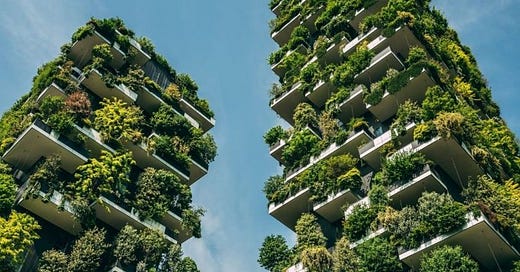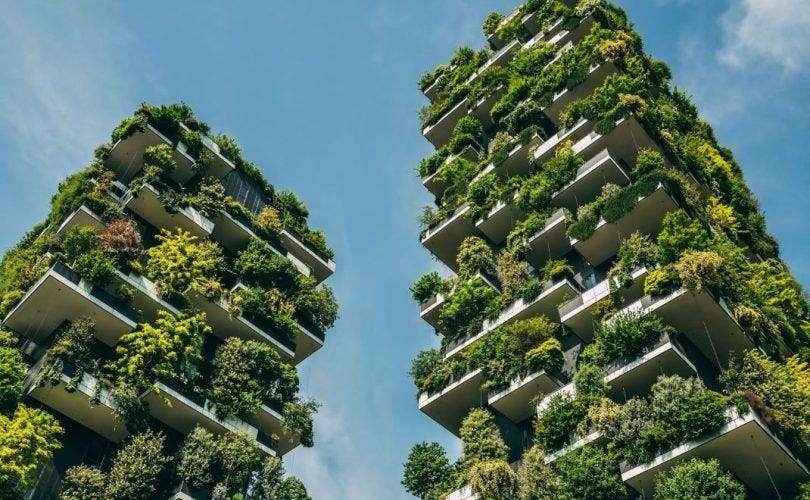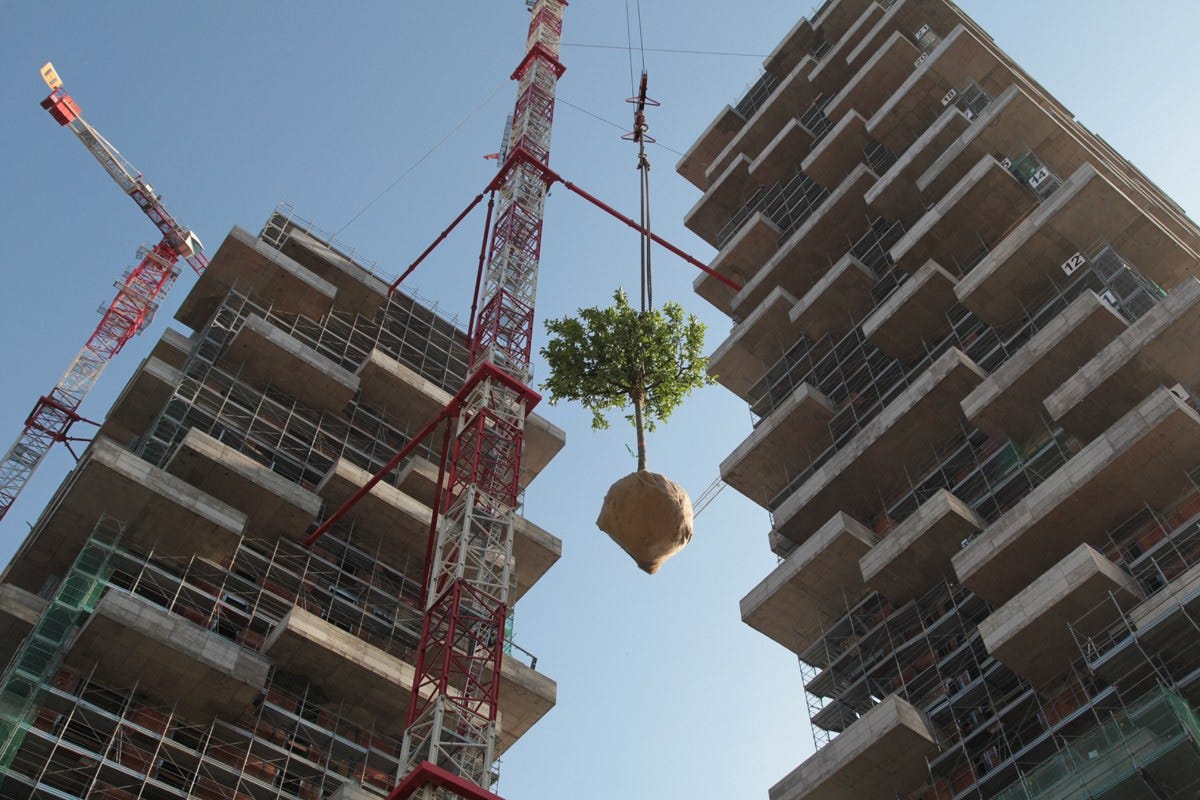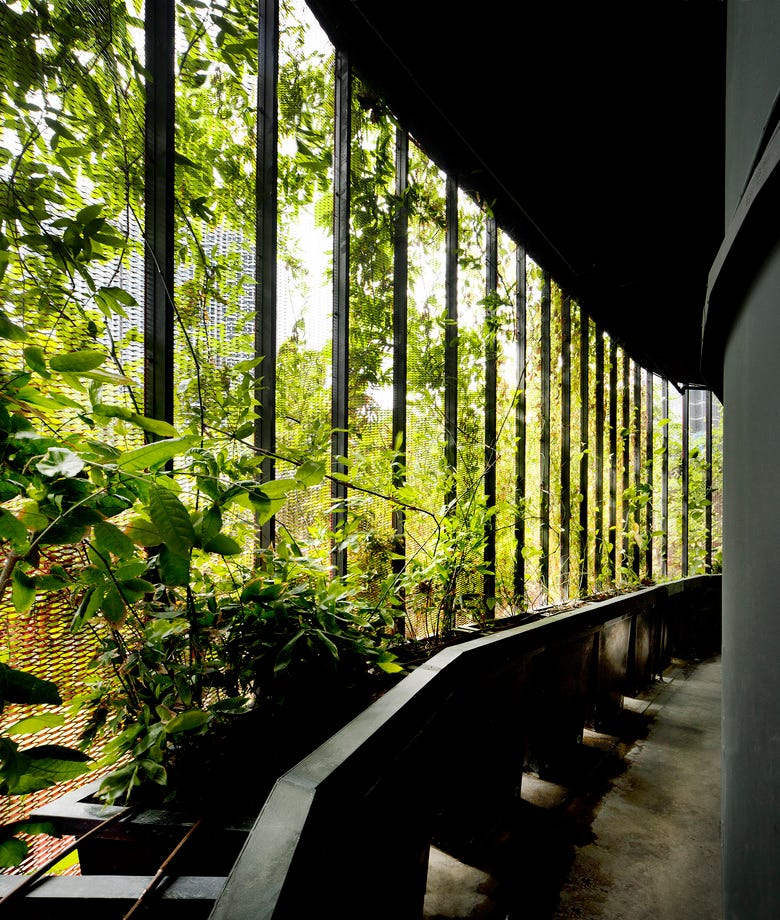Solarpunk has a different take on buildings covered with plants than traditional SciFi. In series like The Last of Us (pictured above) green growth on the walls of apartment blocks signifies the collapse of society. In solarpunk it's a symbol of a new flourishing for cities.
Probably no single image has become more used with solarpunk than the tree-covered balconies of the Bosco Verticale in Milan. But the Italian tower’s design is not the only way to use plants on buildings, and may not be the best one.
[Trees to the sky IMAGE: Boeri Studio]
Plant covered exteriors bring a bunch of benefits to urban environments. These include combating air pollution, increasing biodiversity, improving wellbeing, absorbing CO2 and helping cool buildings. According to some studies, the cooling of hard surfaces can be as much as 17 degrees Celsius.
However a number of people have criticised trees on buildings. This article by 99% Invisible says the embodied carbon cost of the reinforced concrete needed for the extra weight of the trees, as well as the extensive watering systems outweigh their CO2 gains.
[Heavy Lifting IMAGE: Vertical Forest via Boeri Studio]
Another criticism is these arboreal towers are not good for their greenery. Trees isolated on balconies are not nearly as healthy as they would be if they were in a setting where they could share water and nutrients through their root systems with others.
Another point is that trees on the ground around the base of the tower could be enjoyed by everyone in the local area, not just private residents.
Does this mean that all plant-covered buildings are unworthy of being associated with solarpunk? Potentially not.
[Creepers for good? IMAGE: Oasia Hotel via WOHA Architects]
The Oasia Hotel’s use of creepers to cover its exterior is arguably more sustainable. These plants are naturally better adapted to cover vertical surfaces and so don’t seem to come with as many of the drawbacks as trees on balconies.
In the case of Oasia the vines cover an outer metal skin of the tower in Singapore. This helps provide a form of natural air cooling in this tropical climate. Designers, WOHA Architects, say it uses harvested rainwater to keep the plants watered.
Downtown Singapore has much less ground level space around it than the Bosco Verticale, so growing upwards is one of the only ways to bring more greenery to the area. Its reported to provide a habitat for lizards, insects and even squirrels.
[Metal Skin made Green IMAGE: Woha Architects]
For less tropical climates moss might provide a better way. German-based company Green City Solutions has been creating walls made up of the stuff which can also double as city benches.
They claim one of these can absorb as much carbon as 275 trees as well as doing a great job at fighting air pollution. Moss also needs less water and is more resistant to seasonal weather fluctuations than other plants.
[Taking a breather IMAGE: A Green City Solution ‘City Tree’ via World Atlas]
A Dutch startup Respyre is one of a number of companies developing a form of ‘bioreceptive’ concrete which can grow moss straight from a building's walls. They claim this type of concrete is 87% circular and CO2 trapping making it effectively carbon negative.
[A concrete solution for a solarpunk city? IMAGE: Trendhunter]
What do you think fellow solarpunk? In spite of its critics is the Bosco Verticale is still worth it for its aesthetic and biodiversity benefits?
Which of these plant coverings for buildings is your favourite? Do you think we should see more of any one type of them represented in solarpunk art?
Do you have examples of plant covered buildings that you rate or hate? Let us know in the comments below.
Until Next Time
That's all for this update. If you like what we’re trying to do here and know someone else who might do too then please like, comment and share.
See you in the sunshine,
Alex Holland
Founder, SolarPunk Stories











One of the many roofs of the Javits Center has a nice greenery/solar panel combo, it looked quite picturesque in the misty rain on Saturday!